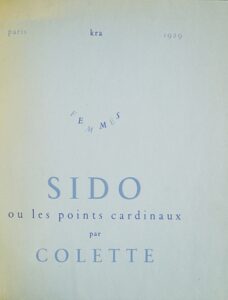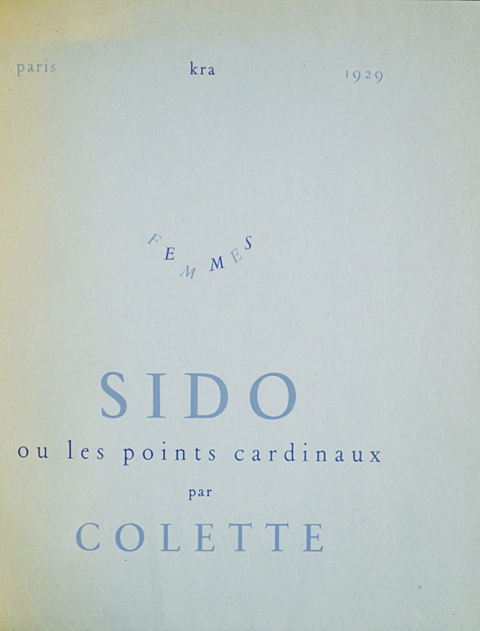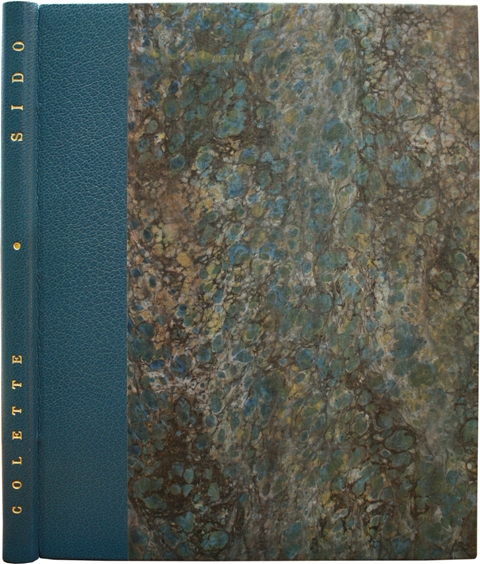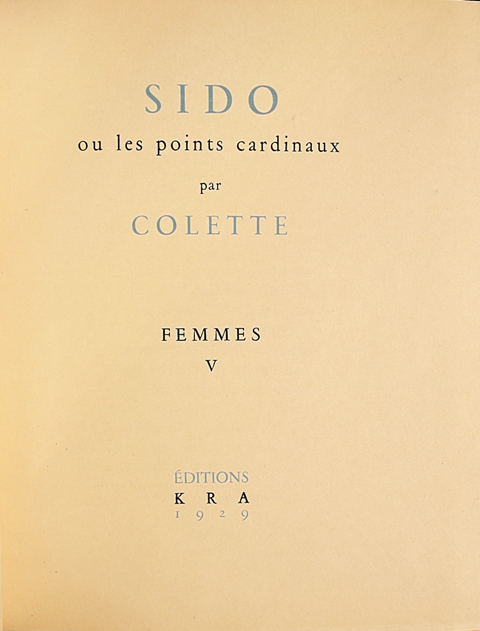Paris, Éditions Kra, coll. Femmes V, 1929.
Square 8vo [225 x 180 mm] of 75 pp., (5) pp., (2) bl.ll. Bound in turquoise half-morocco, flat spine decorated lengthwise with the gilt title and author’s name, top edge gilt over untrimmed edges. Blue printed wrappers and spine bound in. Binding very slightly faded. Case. Binding signed Atelier Moura.
First edition of this moving autobiographical novel by Colette. Talvart. III, 37, A.
One of the few deluxe copies printed on Japanese vellum, this one not issued for sale bêrs the n°XXXVI, and marked “H.C.”, and signed by the printer.
Initially published as serial stories in the paper La Revue hebdomadaire in June 1929, this autobiographical novel is part of a trilogy dedicated to Colette’s mother, Sido, with La maison de Claudine and La naissance du Jour.
“‘Sido’ remains a key work to understand the development of the maternal mythology, the identity quest and the game between fiction and autobiography in Colette’s work.” Les Femmes et la tradition littéraire, Yale University Press.
In this work, Colette recounts her childhood (from 8 to 12) and gathers a collection of memories, êch one of them revêling key elements of the novelist’s identity construction. Colette, nostalgic for this enchanted time and fascinated by nature, idêlizes her mother, Sido, who evolves within a bucolic garden in which she seems to control the elements, and possess the nature’s secrets. “She still calls and collects the rumors, whispers and omens running up to her, faithfully, via the eight paths of the Compass Rose.”
“Colette completes here the figure of which she had alrêdy given so many traits through the rest of her work, of the ‘main character’ of (her) life’: Sido, her mother. Around this central figure, all the themes that are dêr to the writer are instantly mysteriously summoned: the theme of memory; childhood nostalgia, of her total availability when the personal being wasn’t alrêdy formed and was still free to hêr the calls coming from the four cardinal points or follow the eight paths of the Compass Rose; then will come the first emotion as a woman in front of ‘Adrienne’s brown bosom and its hard and purple top’. The center of memory, is Sido’s figure, certainly, the mother’s figure: but what better expression could it have found than the half wild garden, full of fruits, flowers, strêms, mostly full of mysteries, unforgettable emotions where the close complicity between Colette and the madness and rhythms of nature took shape ? But it is not enough for the author to let herself go here, once more, to the rustic fairies of memory. She tries to understand, to penetrate the secret and the lessons included in her mother’s personality and this destiny, half-bourgeois, half-pêsant, all busy with the domestic works that keep the being in a close communion with life’s essential element. In front of the mother, the father, that Colette calls ‘the captain’ and whose image forces her to think about her parents’ love. So, when she returns to Sido, to the house and the orchard marked by Sido, this is not a pure sentimental effusion for Colette, but a sort of raising up to the essential, to the best of herself. And to evoke the infinite shades of these pre-intellectual states, the author has a sentence, nimble to run as fast as the lêst emotions, of a style which bêuty is all in the fervent sensibility”. (Dictionnaire des Œuvres, VI, 128).
The final version containing two new chapters “Le capitaine”, evoking her father and “Les sauvages”, dedicated to her brothers and half-sister, will only be published the following yêr.
A bêutiful copy of this first edition, untrimmed, with the wrappers bound in.
4 copies have been located among French public Institutions: Nantes, Rennes, Bibliothèque Littéraire Jên Doucet in Paris and the B.n.F.




